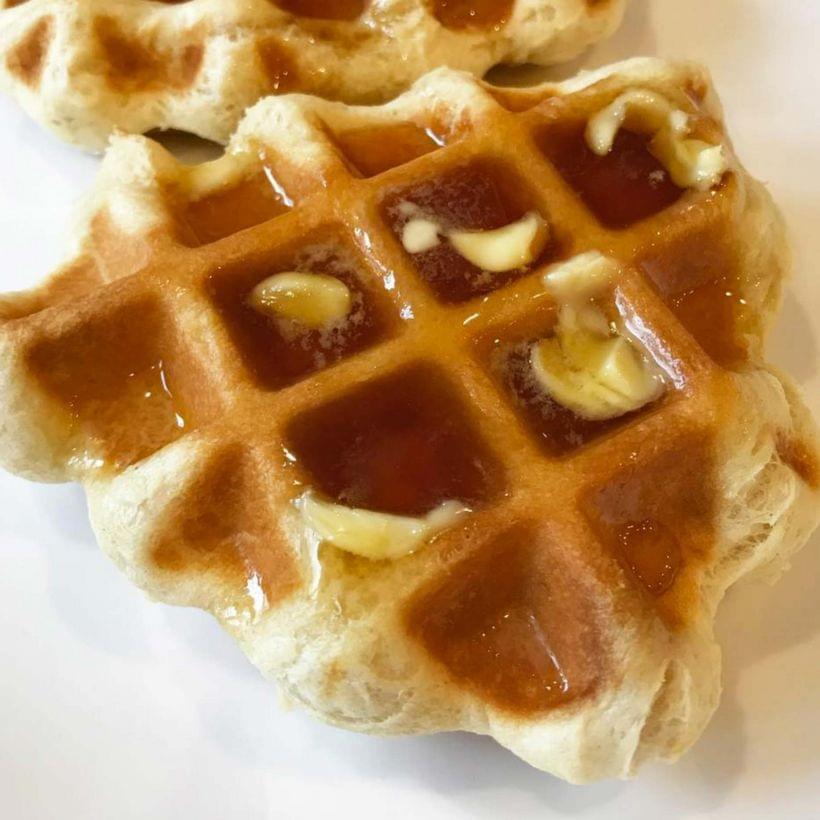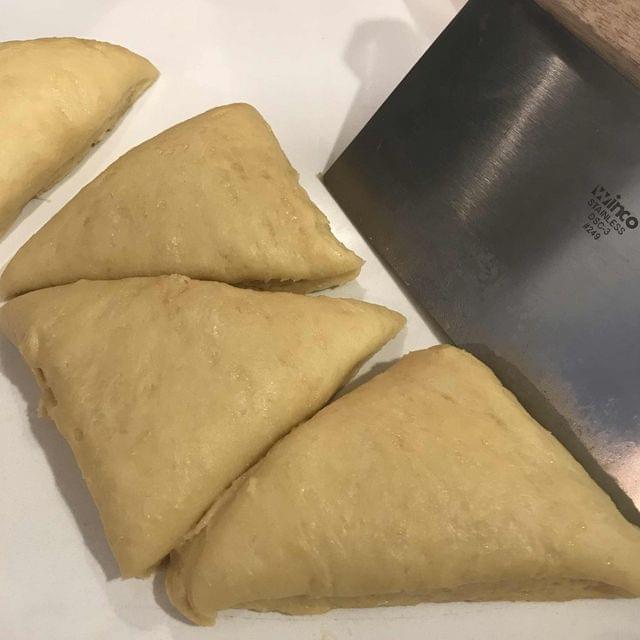Liège Waffles
Skip to the recipe
Anything can be part of a complete breakfast if you believe in yourself.
A long, long time ago I worked a retail job with a man named Mike “Gunface” McKenzie, guitarist and vocalist for the metal band The Red Chord. This is a recipe for waffles. Stay with me, here.
Mike did a lot of stomping and roaring. Generally, I mean. It wasn’t always in response to anything, even; just the way he moved through the world. He was a friendly, positive, boundlessly enthusiastic dude.
More often than not, the arrival of his lunch would be heralded by a booming, guttural, extremely metal “RRRGH I LOVE FOOD.” You could hear it throughout the entire lousy store, followed by a series of similarly audible war-stomps toward the breakroom. This wasn’t, like, with regards to any specific food. Mike was just pumped as hell that some food was around, and he could eat it. If the food was itself very good, oh man, what a time to be alive. But the baseline experience was:
- THERE IS FOOD
- I CAN EAT IT
- RRRARRGH
This is a life lesson that I have taken to heart.
I almost named this site “Haute Garbage” instead of the much less catchy “Wilto Makes Food.” What stopped me was that “garbage” part; like certain ingredients would imply some kind of negative value, and that isn’t how I do. Food is great. A delicate, shatteringly crisp mille-feuille is great. A hot bowl of Spaghetti-Os is great. Maybe you’re into kale, and like, alright, yeah, nice. A fistful of Doritos straight off the kitchen counter? Nice. Far as I’m concerned, if you’re gonna try to go around assigning some kind of righteous value to food, you’ll only do worse than “we should make sure everyone has some.” Maybe start and end there.
I found out that Mike McKenzie did some sound work for Sesame Street, a few years back—specifically, for a short animation about potty training. I think he narrated it, too. All of this absolutely makes sense to me. When asked during an interview whether he’d drawn inspiration from watching Sesame Street as a kid, well, his answer might be part of the origins of the valuable lesson he taught me:
I still have the song “Everybody Eats” in my head from time to time.
RRRARRGH
Were you gonna talk about the waffles, or..?
Yeah—they’re pretty good, I think. I’ve been working on this recipe for a couple weeks now; it includes four (4) kinds of sugar and zero (0) moral value. I didn’t “sneak” yogurt into ’em, as though that would make them, like, more morally just waffles. They aren’t some scandalous indulgence. Their redeeming quality is that they’re waffles. You can have some waffles if you want some, and that is great. Roar and stomp around your kitchen and enjoy the hell out of these.

This is a yeast-raised dough, so it behaves a little more like bread dough than the much wetter steam/baking powder/baking soda leavening of more American waffle batters. I find it easier to work with, personally, but bread doughs are right in my baking comfort zone. Even if they aren’t in yours, give this recipe a shot—a dough this rich isn’t gonna be fussy at all.
Now, while it is typical of American waffles, buttermilk isn’t typical of fancier, dessert-ier waffles like these. Here, it serves two purposes: I’d first tried it out in an effort to make the browning a little more manageable, which it seems to, if only a little. Mostly though, I found that the tang of the buttermilk keeps these from tipping too far into “dessert” territory. I mean, if “make it sweeter” was the whole endgame, we could make cookies instead. The buttermilk gives them a little more complexity; it serves as a better backdrop for the crunches of pearl sugar throughout. You can sub it out for milk if you’re not into it, but you might need to dial your waffle maker down a little lower.
Speaking of the pearl sugar, that stuff is non-negotiable. I tried chucking in some granulated sugar at the last-minute, or subbing in sparkling sugar, and both times the heat broke it down too quickly. The dough got sweeter, but you lost the contrast and—yeah, I’ll say it—the mouthfeel of those crispy little candy bits. Some of them do break down, especially near the surface. It feels like we’re adding a lot of ’em during that final step, but it ends up working out.
I’d call these “topping-optional” thanks to the pearl sugar bits, but I’m not gonna judge you for drizzling some maple syrup on there or giving them a light dusting of powdered sugar. I’m not gonna judge you for pretty much anything you do to enhance your, y’know, waffle experience. That’s basically my entire deal.
Recipe: Liège Waffles
Don’t skip the pearl sugar—it’ll make or break this one, trust me. You can sub out the buttermilk for whole milk, but you might need to lower the heat on your waffle maker.
Ingredients
-
500 G. Pastry Flour, though all-purpose flour will work
-
50 G. Wheat Flour
-
2 Tbsp. Granulated Sugar
-
2 Tbsp. Light Brown Sugar
-
1 tsp. Kosher Salt
-
21/4 tsp. Instant (Rapid-Rise) Yeast
-
2 Tbsp. Honey
-
3/4 C. Buttermilk, at room temperature; milk will work too (see recipe notes)
-
10 Tbsp. Unsalted Butter
-
2 Large Eggs, straight from the fridge
-
1/2 C. Pearl Sugar
Instructions
In a large mixing bowl, or bowl of a stand mixer, stir together the flours, sugars, salt, and yeast. Add buttermilk, honey, and eggs, mixing until as close to fully incorporated.
With the mixer running on low speed (or hand-mixing continually), add butter a tablespoon at a time; this step isn’t particularly fussy. Once no dry ingredients remain and the dough has come together into a shaggy ball, add pearl sugar and thoroughly fold it into the dough by hand.
Form dough into a rough ball and set it in a clean, lightly greased bowl. Cover and allow it to rise for about an hour.
After the hour has elapsed, preheat your waffle maker to low-medium heat. Remove dough to a lightly greased surface and roll it out to a thickness of half an inch or so, then cut it into rough chunks with a bench scraper. The size and shape of these are gonna depend on your waffle maker—just make sure you leave enough room for them to expand. Allow the dough to rest for twenty minutes before pressing it into a well-greased waffle iron.